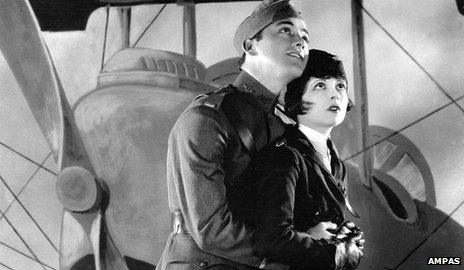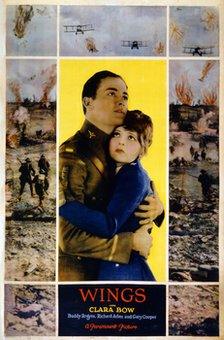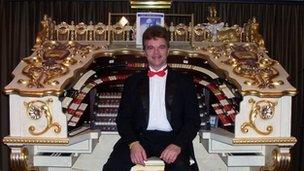First Oscar winner Wings flies back on to big screen
- Published

Charles "Buddy" Rogers and Clara Bow in Wings in 1927
As silent movie The Artist tap-dances its way through awards season, we look back at the first movie to win the Academy Award for best picture, 1927's silent epic Wings.
As movie historians will tell you, Wings wasn't just the first film to win a best picture Oscar; it is also the only silent film to achieve that accolade.
By the time Wings took the top prize at the inaugural Oscar ceremony at Hollywood's Roosevelt Hotel in 1929, the advent of "talkies" was already sweeping the silent era aside.
Starring Clara Bow, Charles "Buddy" Rogers and Richard Arlen, Wings tells the story of two young men who become World War I fighter pilots.
The film is notable for several reasons: its aerial battles, a semi-nude scene involving Clara Bow, a drinking sequence in a Paris bar and some man-to-man kissing.
It also briefly features Gary Cooper in an early role before he shot to Hollywood stardom.
"Wings was definitely the Star Wars, Titanic or Avatar of its day," says Randy Haberkamp, director of educational programmes at the Academy of Motion Picture Arts and Sciences (Ampas).
"It's a blockbuster with dynamic state-of-the-art action sequences. Shot at the end of the silent era, it was released in major cities with live sound effects performed behind the screen."

Wings was victorious at the first Oscars ceremony in 1929
This week, a 21st Century US cinema audience will once again get the chance to see Wings on the big screen in a restored version that includes the original colour tints - with live organ accompaniment by silent film music maestro Clark Wilson, external.
The event is part of the celebration of Paramount Pictures' 100th anniversary, external.
"As far as I know, this is the first time in 80 or 90 years that Hollywood has embraced the organ again to score silent movies," Wilson tells the BBC by phone from his native Ohio.
The organist, who has been playing at silent screenings since the 1980s, will recreate the film's original score along with popular tunes from World War I.
In keeping with the style of the silent era, Wilson will accompany the film using a 10-page cue sheet - a "road map" with 21 separate themes.
"While it won't be specifically note for note what you might have heard in 1927, it's what I would have played at a theatre in 1927."
For practical reasons, Wilson points out, organists rarely played from a full musical score - making each performance unique.
But with Wings lasting two hours and 20 minutes, Wilson admits that the organist has an exhausting task.
"Wings has an intermission, but nevertheless you are absolutely wrung out at the end."
But Wilson says the music mustn't get in the way of the movie.
"In silent cinema, the music can improve a bad picture, or ruin a good one. If we do our job right we disappear behind the film.
"I've had people say they came to watch the organist, but they forgot I was there. That's the sweetest compliment that you can get."
So what is about Wings that made it a worthy first Oscar winner?
Directed by William A Wellman, the film picked up a second Oscar for engineering effects.
Haberkamp says: "Wings was using sound, music, screen size and colour in revolutionary ways for 1927.

Clark Wilson has accompanied hundreds of silent films during his career
"Most importantly in the pre-green screen, pre-CGI era, its stunts required pilots to perform amazing sequences using real planes.
"The actors were shot in flight, as the actual pilot ducked down to allow the cameras to film the actors faces directly."
Shot less than a decade after World War I , the film received support from the American military, yet its budget was nearly $2m at a time when the average film cost about $200,000.
According to Haberkamp, even $1m was considered "extravagant".
"Wings has the biggest rollercoaster of emotions of any silent film that I know," adds Clark Wilson.
"While the battle scenes are incredible, I think the death scene carries more emotion than people expect.
"I've heard many people over the years say they thought silent films were all like the Keystone Kops with out-of-tune piano music - and they couldn't believe that this one made them cry like babies."
Wings screens on Wednesday 18 January at the Samuel Goldwyn Theater in Beverly Hills, California.
- Published17 November 2011
- Published17 January 2012